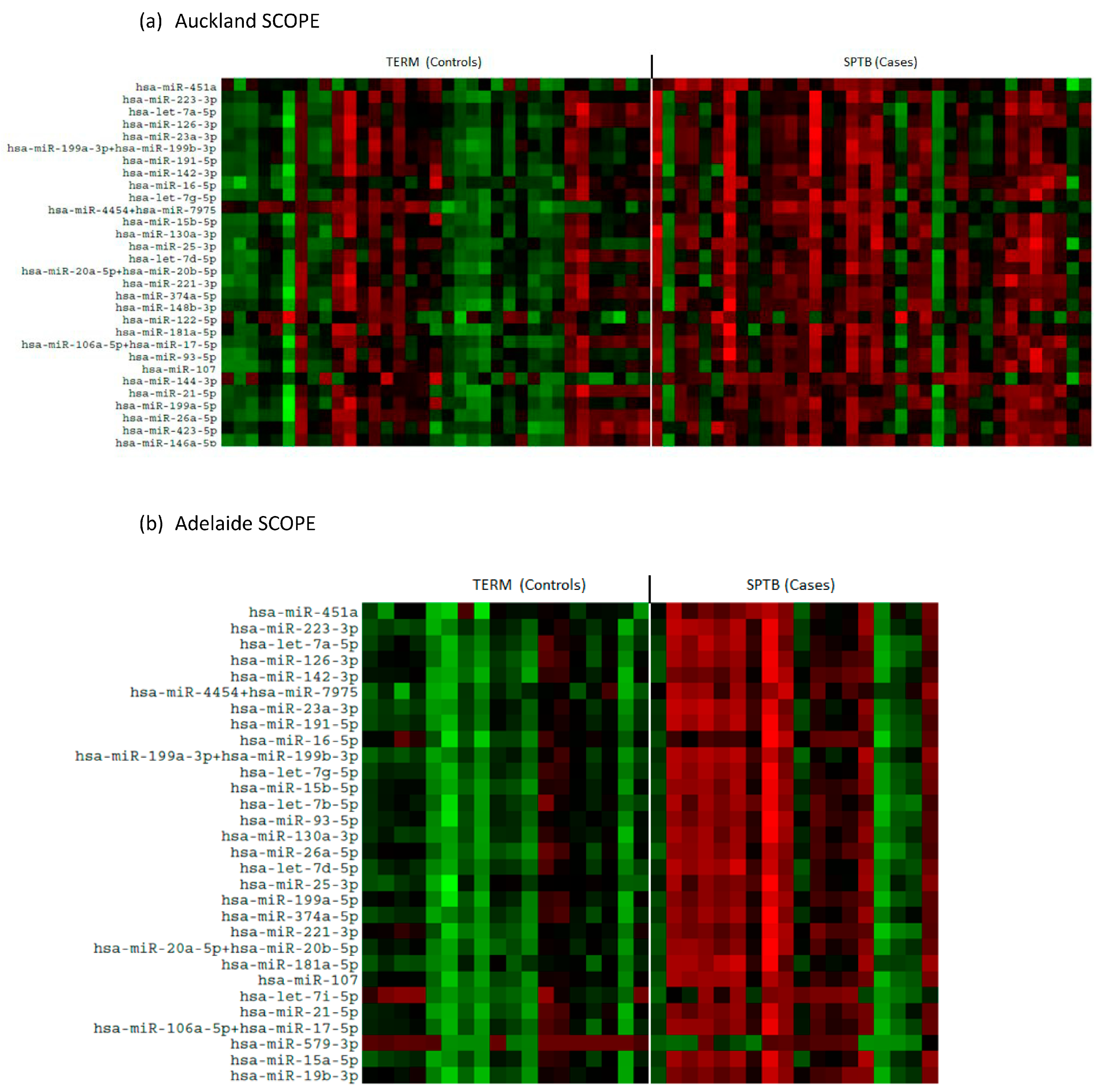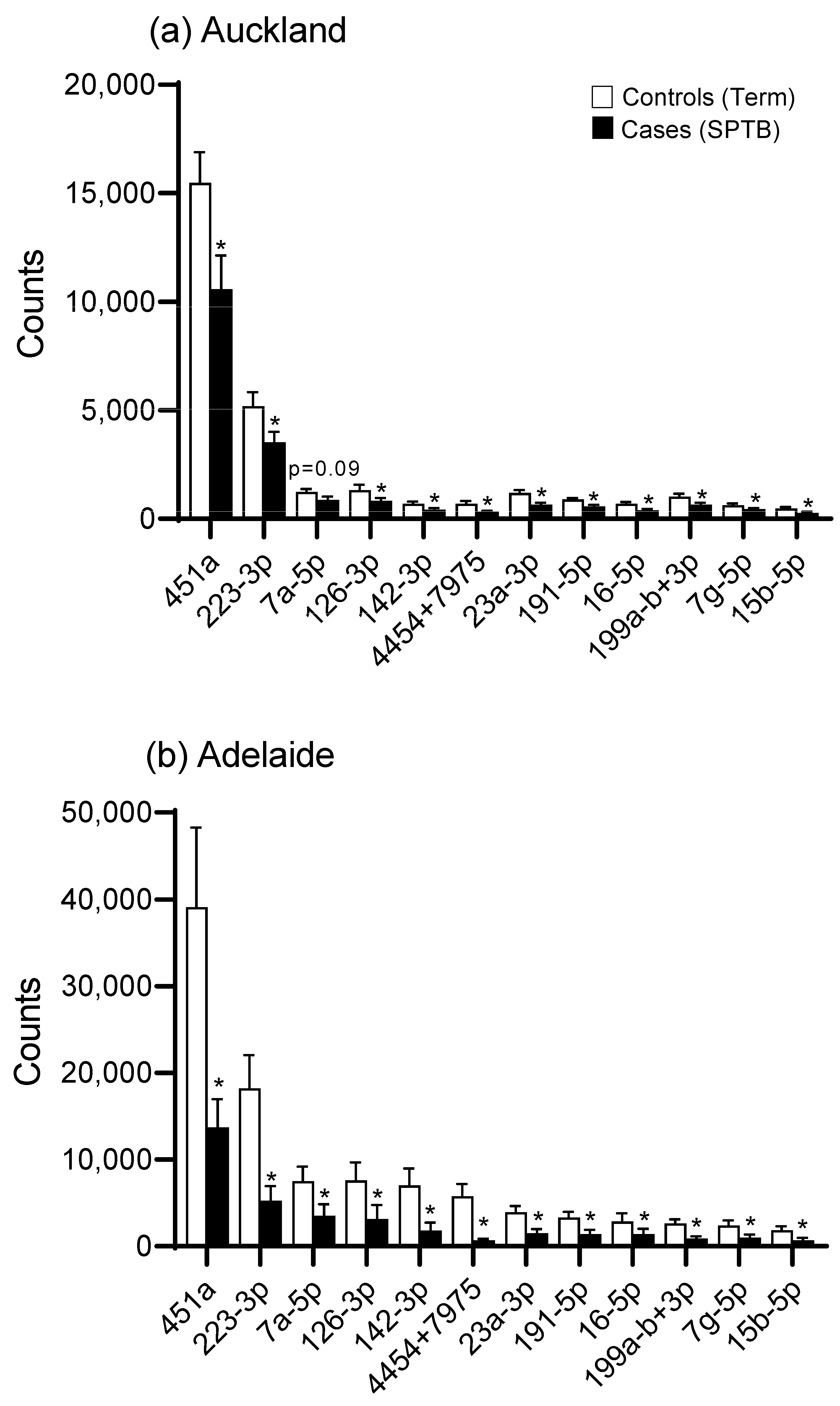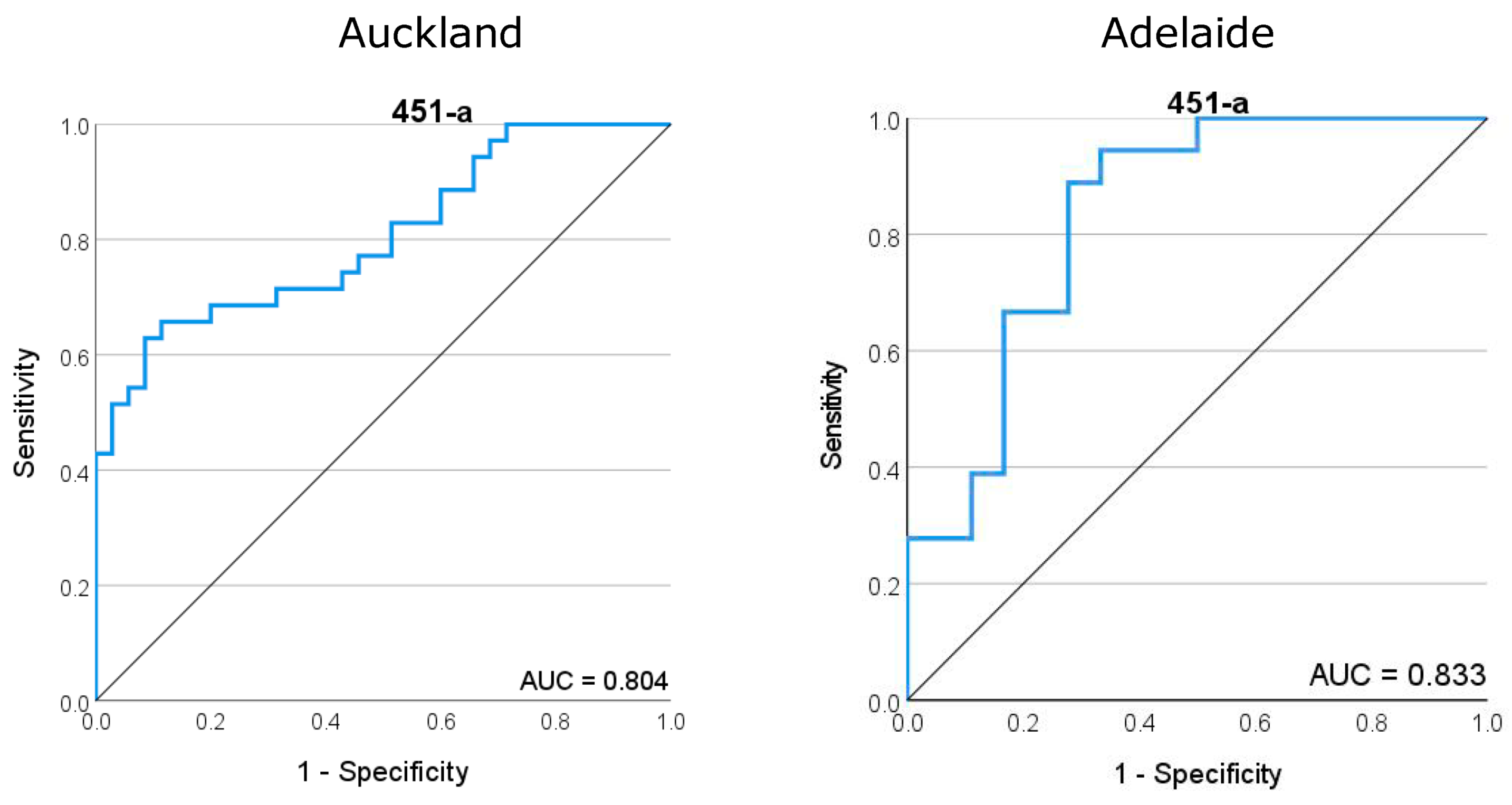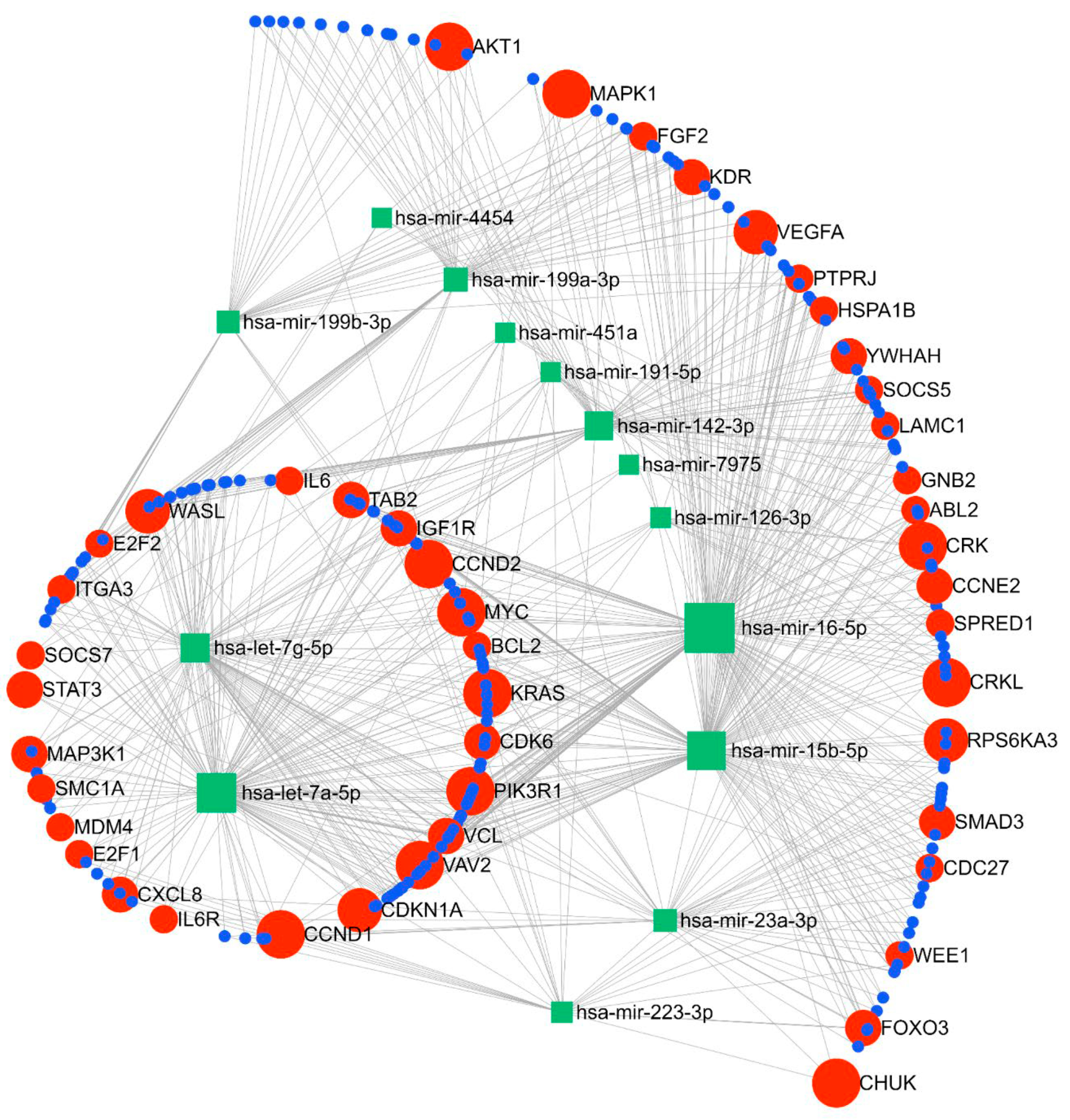Maternal Plasma miRNAs as Early Biomarkers of Moderate-to-Late-Preterm
Abstract
:1. Introduction
2. Results
2.1. Gene Abundance
2.2. miRNA Pathway Analysis
3. Discussion
Strengths and Limitations
4. Materials and Methods
4.1. Cohorts
4.2. miRNA Analysis
4.3. Gene Expression Analysis
4.4. miRNA Pathway Analysis
Supplementary Materials
Author Contributions
Funding
Institutional Review Board Statement
Informed Consent Statement
Data Availability Statement
Acknowledgments
Conflicts of Interest
References
- Walani, S.R. Global burden of preterm birth. Int. J. Gynecol. Obstet. 2020, 150, 31–33. [Google Scholar] [CrossRef]
- Blencowe, H.; Cousens, S.; Oestergaard, M.Z.; Chou, D.; Moller, A.-B.; Narwal, R.; Adler, A.; Garcia, C.V.; Rohde, S.; Say, L.; et al. National, regional, and worldwide estimates of preterm birth rates in the year 2010 with time trends since 1990 for selected countries: A systematic analysis and implications. Lancet 2012, 379, 2162–2172. [Google Scholar] [CrossRef] [PubMed]
- Liu, L.; Johnson, H.L.; Cousens, S.; Perin, J.; Scott, S.; Lawn, J.E.; Rudan, I.; Campbell, H.; Cibulskis, R.; Li, M.; et al. Global, regional, and national causes of child mortality: An updated systematic analysis for 2010 with time trends since 2000. Lancet 2012, 379, 2151–2161. [Google Scholar] [CrossRef]
- Lawn, J.E.; Kerber, K.; Enweronu-Laryea, C.; Cousens, S. 3.6 Million neonatal deaths—What is progressing and what is not? Semin. Perinatol. 2010, 34, 371–386. [Google Scholar] [CrossRef]
- Lawn, J.E.; Cousens, S.; Zupan, J. 4 million neonatal deaths: When? Where? Why? Lancet 2005, 365, 891–900. [Google Scholar] [CrossRef]
- Salmeri, N.; Alteri, A.; Farina, A.; Pozzoni, M.; Vigano’, P.; Candiani, M.; Cavoretto, P.I. Preterm birth in singleton pregnancies conceived by in-vitro fertilization or intracytoplasmic sperm injection: An overview of systematic reviews. Am. J. Obstet. Gynecol. 2024. [Google Scholar] [CrossRef] [PubMed]
- Ramzan, F.; Vickers, M.H.; Mithen, R.F. Epigenetics, microRNA and Metabolic Syndrome: A Comprehensive Review. Int. J. Mol. Sci. 2021, 22, 5047. [Google Scholar] [CrossRef] [PubMed]
- Mavreli, D.; Papantoniou, N.; Kolialexi, A. miRNAs in pregnancy-related complications: An update. Expert Rev. Mol. Diagn. 2018, 18, 587–589. [Google Scholar] [CrossRef] [PubMed]
- Subramanian, A.; Weiss, D.; Nyhan, K.; Dewan, A.; Jukic, A.M.Z. Circulating miRNAs in the first trimester and pregnancy complications: A systematic review. Epigenetics 2023, 18, 2152615. [Google Scholar] [CrossRef]
- Guo, L.; Tsai, S.Q.; Hardison, N.E.; James, A.H.; Motsinger-Reif, A.A.; Thames, B.; Stone, E.A.; Deng, C.; Piedrahita, J.A. Differentially expressed microRNAs and affected biological pathways revealed by modulated modularity clustering (MMC) analysis of human preeclamptic and IUGR placentas. Placenta 2013, 34, 599–605. [Google Scholar] [CrossRef] [PubMed]
- Li, H.; Ge, Q.; Guo, L.; Lu, Z. Maternal plasma miRNAs expression in preeclamptic pregnancies. BioMed Res. Int. 2013, 2013, 1970265. [Google Scholar] [CrossRef]
- Xu, P.; Zhao, Y.; Liu, M.; Wang, Y.; Wang, H.; Li, Y.X.; Zhu, X.; Yao, Y.; Wang, H.; Qiao, J.; et al. Variations of microRNAs in human placentas and plasma from preeclamptic pregnancy. Hypertension 2014, 63, 1276–1284. [Google Scholar] [CrossRef]
- Kim, S.H.; MacIntyre, D.A.; Binkhamis, R.; Cook, J.; Sykes, L.; Bennett, P.R.; Terzidou, V. Maternal plasma miRNAs as potential biomarkers for detecting risk of small-for-gestational-age births. EBioMedicine 2020, 62, 103145. [Google Scholar] [CrossRef] [PubMed]
- Elovitz, M.A.; Brown, A.G.; Anton, L.; Gilstrop, M.; Heiser, L.; Bastek, J. Distinct cervical microRNA profiles are present in women destined to have a preterm birth. Am. J. Obstet. Gynecol. 2014, 210, 221.e1–221.e11. [Google Scholar] [CrossRef]
- Elovitz, M.A.; Anton, L.; Bastek, J.; Brown, A.G. Can microRNA profiling in maternal blood identify women at risk for preterm birth? Am. J. Obstet. Gynecol. 2015, 212, 782.e1–782.e5. [Google Scholar] [CrossRef] [PubMed]
- Hromadnikova, I.; Kotlabova, K.; Ivankova, K.; Krofta, L. Expression profile of C19MC microRNAs in placental tissue of patients with preterm prelabor rupture of membranes and spontaneous preterm birth. Mol. Med. Rep. 2017, 16, 3849–3862. [Google Scholar] [CrossRef] [PubMed]
- Cook, J.; Bennett, P.R.; Kim, S.H.; Teoh, T.G.; Sykes, L.; Kindinger, L.M.; Garrett, A.; Binkhamis, R.; MacIntyre, D.A.; Terzidou, V. First Trimester Circulating MicroRNA Biomarkers Predictive of Subsequent Preterm Delivery and Cervical Shortening. Sci. Rep. 2019, 9, 5861. [Google Scholar] [CrossRef]
- Illarionov, R.A.; Pachuliia, O.V.; Vashukova, E.S.; Tkachenko, A.A.; Maltseva, A.R.; Postnikova, T.B.; Nasykhova, Y.A.; Bespalova, O.N.; Glotov, A.S. Plasma miRNA Profile in High Risk of Preterm Birth during Early and Mid-Pregnancy. Genes 2022, 13, 2018. [Google Scholar] [CrossRef] [PubMed]
- Légaré, C.; Clément, A.A.; Desgagné, V.; Thibeault, K.; White, F.; Guay, S.P.; Arsenault, B.J.; Scott, M.S.; Jacques, P.; Perron, P.; et al. Human plasma pregnancy-associated miRNAs and their temporal variation within the first trimester of pregnancy. Reprod Biol. Endocrinol. 2022, 20, 14. [Google Scholar] [CrossRef]
- Flowers, E.; Kanaya, A.M.; Zhang, L.; Aouizerat, B.E. The Role of Racial and Ethnic Factors in MicroRNA Expression and Risk for Type 2 Diabetes. Front. Genet. 2022, 13, 853633. [Google Scholar] [CrossRef]
- Bovell, L.C.; Shanmugam, C.; Putcha, B.D.; Katkoori, V.R.; Zhang, B.; Bae, S.; Singh, K.P.; Grizzle, W.E.; Manne, U. The prognostic value of microRNAs varies with patient race/ethnicity and stage of colorectal cancer. Clin. Cancer Res. 2013, 19, 3955–3965. [Google Scholar] [CrossRef] [PubMed]
- Brink, L.T.; Roberts, D.J.; Wright, C.A.; Nel, D.G.; Schubert, P.T.; Boyd, T.K.; Hall, D.R.; Odendaal, H. Placental pathology in spontaneous and iatrogenic preterm birth: Different entities with unique pathologic features. Placenta 2022, 126, 54–63. [Google Scholar] [CrossRef] [PubMed]
- Gray, C.; McCowan, L.M.; Patel, R.; Taylor, R.S.; Vickers, M.H. Maternal plasma miRNAs as biomarkers during mid-pregnancy to predict later spontaneous preterm birth: A pilot study. Sci. Rep. 2017, 7, 815. [Google Scholar] [CrossRef] [PubMed]
- Lu, J.; Getz, G.; Miska, E.A.; Alvarez-Saavedra, E.; Lamb, J.; Peck, D.; Sweet-Cordero, A.; Ebert, B.L.; Mak, R.H.; Ferrando, A.A.; et al. MicroRNA expression profiles classify human cancers. Nature 2005, 435, 834–838. [Google Scholar] [CrossRef] [PubMed]
- Gulyaeva, L.F.; Kushlinskiy, N.E. Regulatory mechanisms of microRNA expression. J. Transl. Med. 2016, 14, 143. [Google Scholar] [CrossRef]
- Williams, M.; Cheng, Y.Y.; Blenkiron, C.; Reid, G. Exploring Mechanisms of MicroRNA Downregulation in Cancer. MicroRNA 2017, 6, 2–16. [Google Scholar] [CrossRef]
- Maillot, G.; Lacroix-Triki, M.; Pierredon, S.; Gratadou, L.; Schmidt, S.; Bénès, V.; Roché, H.; Dalenc, F.; Auboeuf, D.; Millevoi, S.; et al. Widespread estrogen-dependent repression of micrornas involved in breast tumor cell growth. Cancer Res. 2009, 69, 8332–8340. [Google Scholar] [CrossRef] [PubMed]
- Cohen, A.; Burgos-Aceves, M.A.; Smith, Y. Estrogen repression of microRNA as a potential cause of cancer. Biomed. Pharmacother. 2016, 78, 234–238. [Google Scholar] [CrossRef]
- Muñoz-Pérez, V.M.; Ortiz, M.I.; Cariño-Cortés, R.; Fernández-Martínez, E.; Rocha-Zavaleta, L.; Bautista-Ávila, M. Preterm Birth, Inflammation and Infection: New Alternative Strategies for their Prevention. Curr. Pharm. Biotechnol. 2019, 20, 354–365. [Google Scholar] [CrossRef] [PubMed]
- Mercer, G.V.; Stapleton, D.; Barrett, C.; Ringer, L.C.M.; Lambe, S.; Critch, A.; Newman, G.; Pelley, A.; Biswas, R.G.; Wolff, W.; et al. Identifying placental metabolic biomarkers of preterm birth using nuclear magnetic resonance of intact tissue samples. Placenta 2023, 143, 80–86. [Google Scholar] [CrossRef]
- Murata, K.; Yoshitomi, H.; Furu, M.; Ishikawa, M.; Shibuya, H.; Ito, H.; Matsuda, S. MicroRNA-451 down-regulates neutrophil chemotaxis via p38 MAPK. Arthritis Rheumatol. 2014, 66, 549–559. [Google Scholar] [CrossRef] [PubMed]
- Yu, D.; dos Santos, C.O.; Zhao, G.; Jiang, J.; Amigo, J.D.; Khandros, E.; Dore, L.C.; Yao, Y.; D’Souza, J.; Zhang, Z.; et al. miR-451 protects against erythroid oxidant stress by repressing 14-3-3zeta. Genes Dev. 2010, 24, 1620–1633. [Google Scholar] [CrossRef]
- Pillay, P.; Moodley, K.; Vatish, M.; Moodley, J. Exosomal MicroRNAs in Pregnancy Provides Insight into a Possible Cure for Cancer. Int. J. Mol. Sci. 2020, 21, 5384. [Google Scholar] [CrossRef]
- Timofeeva, A.V.; Fedorov, I.S.; Sukhova, Y.V.; Ivanets, T.Y.; Sukhikh, G.T. Prediction of Early- and Late-Onset Pre-Eclampsia in the Preclinical Stage via Placenta-Specific Extracellular miRNA Profiling. Int. J. Mol. Sci. 2023, 24, 8006. [Google Scholar] [CrossRef] [PubMed]
- Houshmandfar, S.; Saeedi-Boroujeni, A.; Rashno, M.; Khodadadi, A.; Mahmoudian-Sani, M.R. miRNA-223 as a regulator of inflammation and NLRP3 inflammasome, the main fragments in the puzzle of immunopathogenesis of different inflammatory diseases and COVID-19. Naunyn-Schmiedeberg’s Arch. Pharmacol. 2021, 394, 2187–2195. [Google Scholar] [CrossRef] [PubMed]
- Neudecker, V.; Haneklaus, M.; Jensen, O.; Khailova, L.; Masterson, J.C.; Tye, H.; Biette, K.; Jedlicka, P.; Brodsky, K.S.; Gerich, M.E.; et al. Myeloid-derived miR-223 regulates intestinal inflammation via repression of the NLRP3 inflammasome. J. Exp. Med. 2017, 214, 1737–1752. [Google Scholar] [CrossRef]
- Bauernfeind, F.; Rieger, A.; Schildberg, F.A.; Knolle, P.A.; Schmid-Burgk, J.L.; Hornung, V. NLRP3 inflammasome activity is negatively controlled by miR-223. J. Immunol. 2012, 189, 4175–4181. [Google Scholar] [CrossRef] [PubMed]
- Haneklaus, M.; Gerlic, M.; Kurowska-Stolarska, M.; Rainey, A.A.; Pich, D.; McInnes, I.B.; Hammerschmidt, W.; O’Neill, L.A.; Masters, S.L. Cutting edge: miR-223 and EBV miR-BART15 regulate the NLRP3 inflammasome and IL-1β production. J. Immunol. 2012, 189, 3795–3799. [Google Scholar] [CrossRef] [PubMed]
- Aziz, F. The emerging role of miR-223 as novel potential diagnostic and therapeutic target for inflammatory disorders. Cell. Immunol. 2016, 303, 1–6. [Google Scholar] [CrossRef] [PubMed]
- Wander, P.L.; Boyko, E.J.; Hevner, K.; Parikh, V.J.; Tadesse, M.G.; Sorensen, T.K.; Williams, M.A.; Enquobahrie, D.A. Circulating early- and mid-pregnancy microRNAs and risk of gestational diabetes. Diabetes Res. Clin. Pract. 2017, 132, 1–9. [Google Scholar] [CrossRef] [PubMed]
- Tang, Y.; Ji, H.; Liu, H.; Gu, W.; Li, X.; Peng, T. Identification and functional analysis of microRNA in myometrium tissue from spontaneous preterm labor. Int. J. Clin. Exp. Pathol. 2015, 8, 12811–12819. [Google Scholar]
- Dong, X.; Sui, C.; Huang, K.; Wang, L.; Hu, D.; Xiong, T.; Wang, R.; Zhang, H. MicroRNA-223-3p suppresses leukemia inhibitory factor expression and pinopodes formation during embryo implantation in mice. Am. J. Transl. Res. 2016, 8, 1155–1163. [Google Scholar]
- Cook, J.R.; MacIntyre, D.A.; Samara, E.; Kim, S.H.; Singh, N.; Johnson, M.R.; Bennett, P.R.; Terzidou, V. Exogenous oxytocin modulates human myometrial microRNAs. Am. J. Obstet. Gynecol. 2015, 213, 65.e61–65.e69. [Google Scholar] [CrossRef] [PubMed]
- Winger, E.E.; Reed, J.L.; Ji, X. Early first trimester peripheral blood cell microRNA predicts risk of preterm delivery in pregnant women: Proof of concept. PLoS ONE 2017, 12, e0180124. [Google Scholar] [CrossRef] [PubMed]
- Sheikh, A.M.; Small, H.Y.; Currie, G.; Delles, C. Systematic Review of Micro-RNA Expression in Pre-Eclampsia Identifies a Number of Common Pathways Associated with the Disease. PLoS ONE 2016, 11, e0160808. [Google Scholar] [CrossRef] [PubMed]
- Jiang, S. A Regulator of Metabolic Reprogramming: MicroRNA Let-7. Transl. Oncol. 2019, 12, 1005–1013. [Google Scholar] [CrossRef] [PubMed]
- Wang, Y.; Lv, Y.; Wang, L.; Gong, C.; Sun, J.; Chen, X.; Chen, Y.; Yang, L.; Zhang, Y.; Yang, X.; et al. MicroRNAome in decidua: A new approach to assess the maintenance of pregnancy. Fertil. Steril. 2015, 103, 980–989. [Google Scholar] [CrossRef] [PubMed]
- Fish, J.E.; Santoro, M.M.; Morton, S.U.; Yu, S.; Yeh, R.F.; Wythe, J.D.; Ivey, K.N.; Bruneau, B.G.; Stainier, D.Y.; Srivastava, D. miR-126 regulates angiogenic signaling and vascular integrity. Dev. Cell 2008, 15, 272–284. [Google Scholar] [CrossRef] [PubMed]
- Chamorro-Jorganes, A.; Araldi, E.; Suárez, Y. MicroRNAs as pharmacological targets in endothelial cell function and dysfunction. Pharmacol. Res. 2013, 75, 15–27. [Google Scholar] [CrossRef]
- Xu, J.; Gu, Y.; Lewis, D.F.; Cooper, D.B.; McCathran, C.E.; Wang, Y. Downregulation of vitamin D receptor and miR-126-3p expression contributes to increased endothelial inflammatory response in preeclampsia. Am. J. Reprod. Immunol. 2019, 82, e13172. [Google Scholar] [CrossRef]
- Cui, W.; Li, Q.; Feng, L.; Ding, W. MiR-126-3p regulates progesterone receptors and involves development and lactation of mouse mammary gland. Mol. Cell. Biochem. 2011, 355, 17–25. [Google Scholar] [CrossRef] [PubMed]
- Montenegro, D.; Romero, R.; Kim, S.S.; Tarca, A.L.; Draghici, S.; Kusanovic, J.P.; Kim, J.S.; Lee, D.C.; Erez, O.; Gotsch, F.; et al. Expression patterns of microRNAs in the chorioamniotic membranes: A role for microRNAs in human pregnancy and parturition. J. Pathol. 2009, 217, 113–121. [Google Scholar] [CrossRef]
- Tam, S.; de Borja, R.; Tsao, M.S.; McPherson, J.D. Robust global microRNA expression profiling using next-generation sequencing technologies. Lab. Investig. 2014, 94, 350–358. [Google Scholar] [CrossRef] [PubMed]
- McCowan, L.M.; Thompson, J.M.; Taylor, R.S.; North, R.A.; Poston, L.; Baker, P.N.; Myers, J.; Roberts, C.T.; Dekker, G.A.; Simpson, N.A.; et al. Clinical prediction in early pregnancy of infants small for gestational age by customised birthweight centiles: Findings from a healthy nulliparous cohort. PLoS ONE 2013, 8, e70917. [Google Scholar] [CrossRef]
- McCowan, L.M.; Roberts, C.T.; Dekker, G.A.; Taylor, R.S.; Chan, E.H.; Kenny, L.C.; Baker, P.N.; Moss-Morris, R.; Chappell, L.C.; North, R.A. Risk factors for small-for-gestational-age infants by customised birthweight centiles: Data from an international prospective cohort study. BJOG 2010, 117, 1599–1607. [Google Scholar] [CrossRef] [PubMed]
- Chang, L.; Zhou, G.; Soufan, O.; Xia, J. miRNet 2.0: Network-based visual analytics for miRNA functional analysis and systems biology. Nucleic Acids Res. 2020, 48, W244–W251. [Google Scholar] [CrossRef]
- Bridge-Comer, P.E.; Vickers, M.H.; Morton-Jones, J.; Spada, A.; Rong, J.; Reynolds, C.M. Impact of Maternal Intake of Artificial Sweetener, Acesulfame-K, on Metabolic and Reproductive Health Outcomes in Male and Female Mouse Offspring. Front. Nutr. 2021, 8, 745203. [Google Scholar] [CrossRef]
- Schmittgen, T.D.; Livak, K.J. Analyzing real-time PCR data by the comparative C(T) method. Nat. Protoc. 2008, 3, 1101–1108. [Google Scholar] [CrossRef] [PubMed]





| Auckland | Preterm n = 36 | Term n = 36 | p-Value |
|---|---|---|---|
| Age (years) * | 32.7 (0.70) | 32.4 (0.73) | 0.83 |
| Body Mass Index (kg/m2) * | 24.8 (0.73) | 24.6 (0.58) | 0.87 |
| Primigravid * | 25 (69.4%) | 28 (77.8%) | 0.59 |
| Socioeconomic index score * | 52.5 (2.20) | 54.2 (2.45) | 0.60 |
| Gestation at sampling | 15.6 (0.13) | 15.4 (0.13) | 0.23 |
| Gestation at delivery (weeks) | 33.8 (0.37) | 40.1 (0.18) | <0.0001 |
| Customised birthweight centile | 54.3 (4.97) | 58.1 (3.60) | 0.54 |
| Adelaide | Preterm n = 18 | Term n = 18 | |
| Age (years) * | 24.6 (1.39) | 22.9 (1.06) | 0.35 |
| Body Mass Index (kg/m2) * | 28.3 (1.56) | 26.6 (1.34) | 0.42 |
| Primigravid * | 12 (66.7%) | 16 (88.9%) | 0.23 |
| Socioeconomic index score * | 33.4 (2.90) | 31.5 (3.06) | 0.66 |
| Gestation at sampling | 15.6 (0.14) | 15.7 (0.12) | 0.97 |
| Gestation at delivery (weeks) | 33.8 (0.82) | 40.5 (0.19) | <0.0001 |
| Customised birthweight centile | 52.2 (7.07) | 53.7 (6.27) | 0.88 |
| Rank | Auckland | Adelaide |
|---|---|---|
| 1 | hsa-miR-451-a | hsa-miR-451-a |
| 2 | hsa-miR-223-3p | hsa-miR-223-3p |
| 3 | hsa-let-7a-5p | hsa-let-7a-5p |
| 4 | hsa-let-126-3p | hsa-let-126-3p |
| 5 | hsa-miR-23a-3p | hsa-miR-142-3p |
| 6 | hsa-miR-199a-3p-hsa-miR-199b-3p | hsa-miR-4454-hsa-miR-7975 |
| 7 | hsa-miR-191-5p | hsa-miR-23a-3p |
| 8 | hsa-miR-142-3p | hsa-miR-191-5p |
| 9 | hsa-miR-16-5p | hsa-miR-16-5p |
| 10 | hsa-miR-7g-5p | hsa-miR-199a-3p-hsa-miR-199b-3p |
| 11 | hsa-miR-4454-hsa-miR-7975 | hsa-miR-7g-5p |
| 12 | hsa-miR-15b-5p | hsa-miR-15b-5p |
| Gene Pathway | Pathway Target Genes |
|---|---|
| Cell Cycle | CCND1, CCND2, CDK6, CDKN1A, E2F1, E2F2, MYC, SMC1A, CDC27, SMAD3, WEE1, YWHAH, CCNE2 |
| Focal Adhesion | CCND1, BCL2, CCND2, IGF1R, ITGA3, PIK3R1, VAV2, VCL, CRK, CRKL, KDR, LAMC1, VEGFA, AKT1, MAPK1 |
| Jak-STAT signaling | CCND1, CCND2, IL6R, MYC, PIK3R1, STAT3, SOCS7, SOCS5, SPRED1, AKT1 |
| ErbB signalling | CDKN1A, KRAS, MYC, PIK3R1, ABL2, CRK, CRKL, AKT1, MAPK1 |
| Chemokine signaling | CXCL8, KRAS, PIK3R1, STAT3, VAV2, WASL, CHUK, CRK, CRKL, GNB2, FOXO3, AKT1, MAPK1 |
| Neurotropin signaling | KRAS, MAP3K1, PIK3R1, CRK, CRKL, RPS6KA3, YWHAH, FOXO3, AKT1, MAPK1 |
| mTor signaling | PIK3R1, RPS6KA3, VEGFA, AKT1, MAPK1 |
| P53 signaling | CCND1, CCND2, CDK6, CDKN1A, MDM4, CCNE2 |
| Adherens junction | IGF1R, VCL, WASL, SMAD3, PTPRJ, MAPK1 |
| Fc gamma R-mediated phagocytosis | PIK3R1, VAV2, WASL, CRK, CRKL, AKT1, MAPK1 |
| B cell receptor signaling | KRAS, PIK3R1, VAV2, CHUK, AKT1, MAPK1 |
| VEGF signaling | KRAS, PIK3R1, KDR, VEGFA, AKT1, MAPK1 |
| MAPK signaling | KRAS, MAP3K1, MYC, TAB2, CHUK, CRK, CRKL, FGF2, HSPA1B, RPS6KA3, AKT1, MAPK1 |
| Toll-like receptor signaling | IL6, CXCL8, PIK3R1, TAB2, CHUK, MAPK1 |
| T cell receptor signaling | KRAS, PIK3R1, VAV2, CHUK, AKT1, MAPK1 |
| Fc epsilon RI signaling | KRAS, PIK3R1, VAV2, AKT1, MAPK1 |
Disclaimer/Publisher’s Note: The statements, opinions and data contained in all publications are solely those of the individual author(s) and contributor(s) and not of MDPI and/or the editor(s). MDPI and/or the editor(s) disclaim responsibility for any injury to people or property resulting from any ideas, methods, instructions or products referred to in the content. |
© 2024 by the authors. Licensee MDPI, Basel, Switzerland. This article is an open access article distributed under the terms and conditions of the Creative Commons Attribution (CC BY) license (https://creativecommons.org/licenses/by/4.0/).
Share and Cite
Ramzan, F.; Rong, J.; Roberts, C.T.; O’Sullivan, J.M.; Perry, J.K.; Taylor, R.; McCowan, L.; Vickers, M.H. Maternal Plasma miRNAs as Early Biomarkers of Moderate-to-Late-Preterm. Int. J. Mol. Sci. 2024, 25, 9536. https://doi.org/10.3390/ijms25179536
Ramzan F, Rong J, Roberts CT, O’Sullivan JM, Perry JK, Taylor R, McCowan L, Vickers MH. Maternal Plasma miRNAs as Early Biomarkers of Moderate-to-Late-Preterm. International Journal of Molecular Sciences. 2024; 25(17):9536. https://doi.org/10.3390/ijms25179536
Chicago/Turabian StyleRamzan, Farha, Jing Rong, Claire T. Roberts, Justin M. O’Sullivan, Jo K. Perry, Rennae Taylor, Lesley McCowan, and Mark H. Vickers. 2024. "Maternal Plasma miRNAs as Early Biomarkers of Moderate-to-Late-Preterm" International Journal of Molecular Sciences 25, no. 17: 9536. https://doi.org/10.3390/ijms25179536









